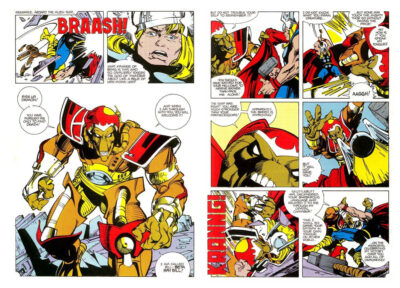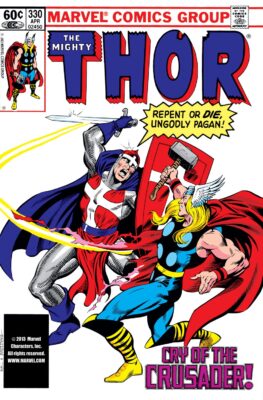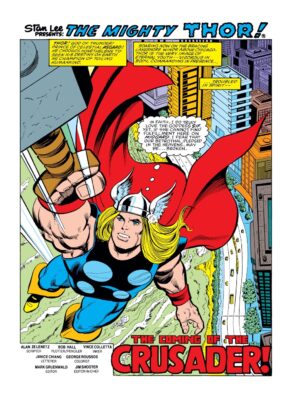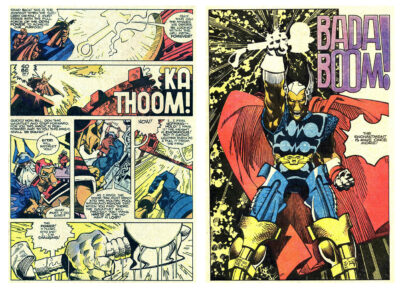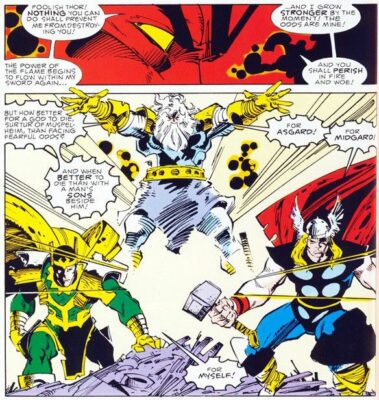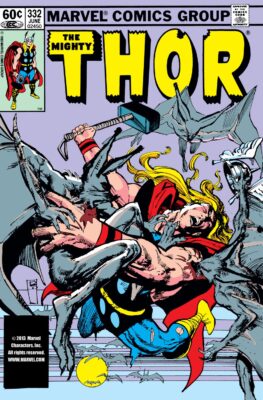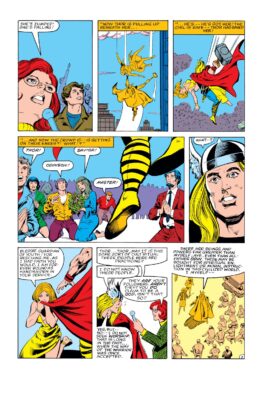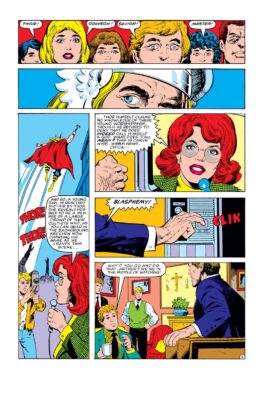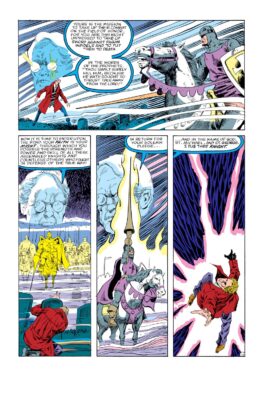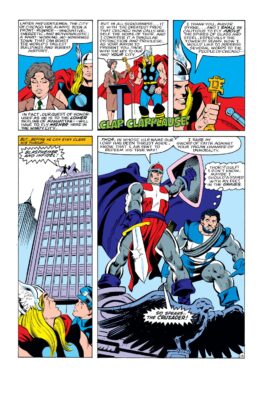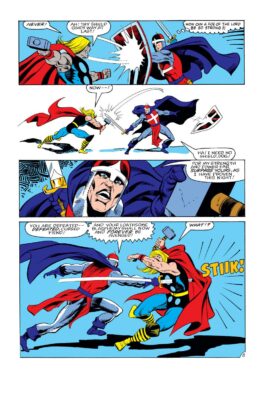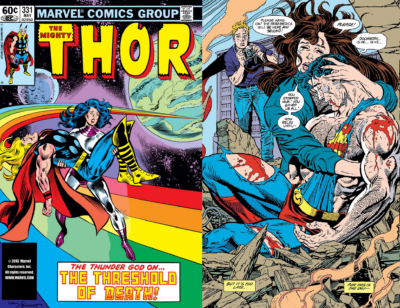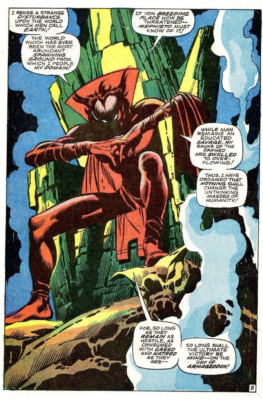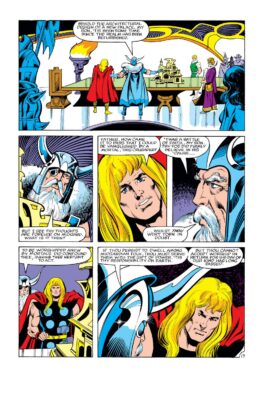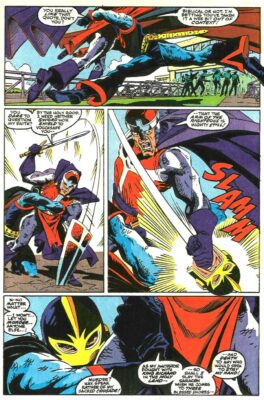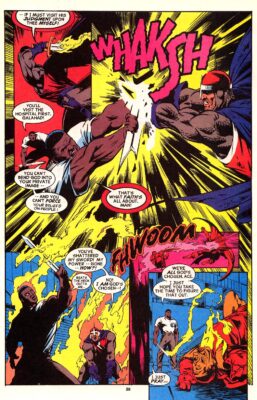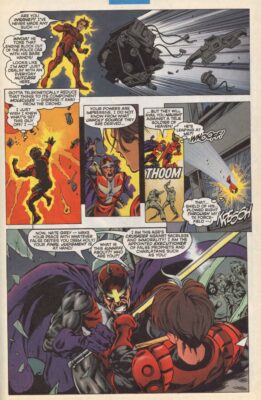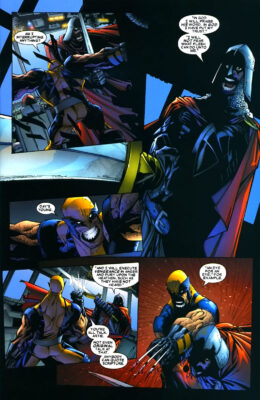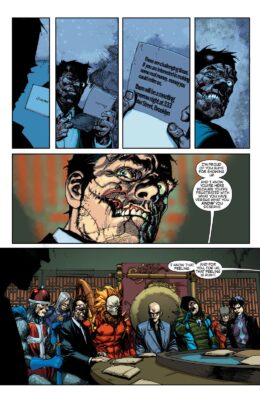Thor’s Holy War: The Crusader Takes a Swing by Anthony Caro
“So what do you think of this issue’s brand-new Thor foe, the Crusader?” goes the question asked in Thor’s monthly letter column, a question likely posed by then editor, the late Mark Gruenwald. After 38 years, the question gets a belated answer.
Walt Simonson truly deserves immense praise for taking the seemingly “tired” Thor hero and revamping the series with the enthusiastic arrival of Beta Ray Bill with issue #337. Arguably, the path to “rebuilding Thor” started a few months earlier, thanks to writer Alan Zelenetz, artist and plotter Bob Hall, and inker Vince Colleta, among others, for heralding “The Coming of The Crusader!” in The Mighty Thor #330 (April 1983).
A cover featuring an angry fellow dressed in a crusader uniform swinging and slashing his broadsword at Thor represents only part of what captivates spinner-rack attention. The villain’s word-balloon warning for the “pagan” Thor to “repent” proves impossible to ignore. Pre-modern age Marvel Comics’ titles steered clear of religious controversies, but this storyline made the controversies central to the plot and villain’s purpose.
A Sales Crusade
The Crusader’s hyped arrival raised eyebrows and likely affected sales. The character didn’t take off, though.
Had the character made his first appearance in 2003, alter ego Arthur Blackwood’s intro likely would follow a debut as a minor character with some “little off” personality issues. The slow burn to villainy would see him become the Crusader in a six-part story arc. Things didn’t work that way back in 1983. Youngsters made up a significant amount of the readership, requiring leaner, simple stories. And The Mighty Thor was not a big enough seller at the time to justify taking any chances since it didn’t have a loyal and massive readership like The Uncanny X-Men. Of course, things changed for the sales-wise better with issue #337.
The 1970s saw the “House of Ideas” deliver tremendous work in several of its B and C-level titles, while more well-known characters creatively coasted. Things changed in the 1980s when Marvel Comics infused more effort into classic titles, such as the Fantastic Four and Captain America. Some characters had a tough time in the 1980s because they seemed locked into a previous era. Thor long maintained a readership, as more than 300 issues suggest, but the hero seemed closer to the 1960s than 1980s. That’s nothing some innovative writing and updating couldn’t cure, as Walt Simonson proved.
The God of Thunder needed some innovation and attention. Fans reading Spiderman, the Incredible Hulk, Daredevil, and the X-Men adventures could appreciate Thor as a guest star or a supporting member of the Avengers, but they might not jump to his solo title without a compelling reason. The interesting two-part Crusader story preceded an offbeat two-parter featuring Dracula. Fans giving 1983 Thor a chance found their 60-cents well spent. Thor was on the road to great things in the middle of ‘83.
The Crusader debuted with marketing hype, as other Marvel titles highlighted issue #330 as a book to check out. The Mighty Thor didn’t usually receive such a plug, but the editorial and marketing teams probably knew the controversial two-parter, one that addressed the cultural impact of Thor’s godhood, would intrigue readers. Regrettably, the Crusader never became what Venom was to Spider-Man or Bane to Batman: a brand-new villain that appears arriving many decades into a heroes publication history to set the comic world on fire and become a recurring, A-list villain. The Crusader represented a near-perfect Thor nemesis, but the character didn’t reach his potential. A change in the creative team soon after his debut likely contributed to his falling behind. Or maybe, the Crusader proved too controversial for the 1980s. He faded out of memory and dropped to D-list forgotten villain status, at least for a while.
Here Comes The Crusader, The Man Without Tolerance
Religious intolerance, fundamentalism, and media agitation appear prominently in the issue’s themes, but Zelenetz and Hall don’t fall into the trap of delivering excessively on-the-nose dialogue or contrived melodrama, The reader gains a subtle understanding of what drives a conflicted villain, and the narrative avoids any overly jarring preachiness. Thor finds he has a cult following, the literal kind. Modern Chicago residents worship Thor the old-school Norse way, as a deity. A news reporter pounces on Thor during an on-camera interview, and the hero quickly downplays his “god status” and neither wants nor needs worshipping.
Seminary student Arthur Blackwood watches the events play out and becomes enraged. Blackwood feels troubled at the church’s indifference to modern paganism and feels great annoyance at seminary head master, Father William’s weakness in the face of the perceived threat, the false god Thor. Father William serves as the voice of reason and not intolerance and suggests Blackwood’s troubled mental state reflects the source of his problems.
For Arthur Blackwood, “paganism” adheres to a very old definition, one that applies to many things commonplace in 1980s Chicago. Neither Thor nor Blackwood feels too comfortable during the impending swan song of the Bronze Age. Culture wars and unhealthy celebrity worship combine toxically with people’s search for meaning. Thor feels driven to do good in the world, and he’s not looking for any thanks. And he certainly doesn’t want people worshipping him. Thor naively doesn’t realize worshippers sometimes choose their gods. Yes, this is a fairly intriguing hero/villain clash, one that offers a bit more than the usual fun Marvel Team-Up outing. That’s not to suggest the story is without its flaws, though. The Crusader’s origin, well, proves lacking. Upon visiting a graveyard, Arthur Blackwood’s father’s ghost sort of shows up and provides his son with visions of ancestors and fundamentalist exploits, including ones during the crusades. Like a rushed House of Mystery story, the apparitions soon depart, leaving Blackwood with a crusader’s armor, shield, and sword, along with Thor-level superstrength derived from channeling all the powers of his ancestors. Is Blackwood some kind of “Bad Shazam?”
Writers can only develop a story so far in a two-part story, and the Crusader’s origin feels extremely rushed by today’s standards, but the plot and conflict moves forward at an acceptable Bronze Age pace. The story remains focused on essential components, character motivations, strong conflict, and a tight narrative. The rushed origin gets a pass. As soon as the Crusader receives his powers, he plots his attack. And readers learn a little bit about his mysterious superpowers. The Crusader’s faith generates his power, and the power is surprisingly immense. He intends to display his faith-driven power at a media event where Chicago’s mayor presents Thor with the keys to the city. Crowds gather. Attendees, prodded by the media, alternatively express support, disdain, indifference, and other attitudes towards the “controversial” figure, a figure who never created his controversies, if they existed at all.
Not letting potential TV exposure become a missed opportunity, the Crusader arrives to challenge Thor, and a brawl breaks out. The hero and villain aren’t the only ones involved in the melee. People in the crowd take sides based on religious and cultural beliefs, and they end up at each other’s throats almost immediately. The final panels that close out issue 330 deliver a brutal shock and a compelling cliffhanger. The Crusader’s sword slashes Thor’s face and draws blood, leaving the Avenger in shock. The sequence evokes Superman’s stunned response when Doomsday first cut the Last Son of Krypton with “bony protrusions” on his hands. The Son of Asgard proves quick to arrive at anger and indignation than Superman, driving a dramatic effect home.
The Crusader, like Doomsday, represents a unique and perilous threat. Thor loses his cool, which could lead to a different outcome than fans routinely expect.
The Holy War Continues
The battle continues in The Mighty Thor #331 (May 1983) with “Holy War!”, and the Crusader maintains his edge. Thor held back somewhat in the previous issue, hoping to restrain the madman. Things take a turn to the shocking in the conclusion. Shocking, but a little rushed.
The drawback of the story’s two-part length reveals itself in another “Death of Superman” prelude where The Crusader kills Thor by driving his sword through the God of Thunder. The issue’s cover, featuring Goddess Sif holding a dying Thor at the gates of Asgard, even shares some similarities with the iconic page from Superman #75 (January 1993) where Lois Lane clutches a recently deceased iconic hero. Unlike the Man of Steel, Thor didn’t overcome the tragedy score of issues later. Sif brings him to Asgard, where Odin regenerates the dying (not dead) Thor.
Thor’s presumed death should have come at the end of part two or three of a four-parter, but that’s not how stories typically played in those days. So, readers lose narrative structural drama but gain added melodrama when Thor uses his near-death experience to realize why he lost to the Crusader: Thor failed in a battle of faith. The concept of faith continues to drive the themes and action in this two-parter. Marvel had an odd way of addressing faith and belief in the old days. Mephisto best represented Marvel’s skittishness about dealing with religion and religious-oriented characters. The demonic devil character was not the devil, but he sure acted like him, albeit with a greater cap on his powers. Supposedly, belief in him as the “real” devil spiked his powers. Faith and belief tended to “power up” those on the receiving end of such convictions, but not enough to reach supreme deity status, if that makes any sense.
The Crusader’s overinflated faith in himself, his beliefs, and his messianic mission gave him powers that edged Thor. The God of Thunder did himself no favors by suffering a crisis of conscience about his antiquated status as a god. Thor reflected after his near-death experience, realizing he lacked faith in his mission on earth. Thor then realized he does what he does not for glory or worship, but for the greater good. The idol worship in his direction led him to doubt his motivations and lose faith. Now understanding his missions on earth remain noble, an empowered Thor confronts the Crusader, a man whose faith draws from comparably weak sources: hate and vengeance. Thor has another use for the “good discovery.” Thor tells his worshippers that the good he serves attracts them, and they should serve goodness instead of him.
The Crusade Fades
The Crusader faded from his villainous potential, not returning to print until Avengers Spotlight #39 (December 1990). The fanatical villain battled the Black Knight in an intriguing story, but nothing that would top sales charts.
The Crusader made another appearance in a strange face-off against Luke Cage in Cage #17 (August 1993), one of those atypical hero/villain meet-ups along the lines of Doctor Octopus appearing in a Captain America book.
Six years would pass before the Crusader picked another battle, and his ire exploded in X-Man #48 (February 1999),
and the oddly paired hero and villain crusade went on hiatus again until Wolverine Vol 3 #42 (July 2006),
fitting into the Civil War story arc and meeting a presumed demise. Other than a flashback cameo in New Avengers #35 (December 2007), creators and editors gave up on Arthur Blackwood.
Arthur Blackwood, the Crusader, never returned to Thor comics. That’s a surprise given the initial hype for his debut and his perfect fit as a Thor villain.
If you’re reading this and you write or edit for Marvel Comics, how about….?
Anthony M. Caro wrote the essay collection Universal Monsters and Neurotics: Children of the Night and their Hang-Ups and the sci-fi serial Why Does Cal Draw Stick Figures at 3 AM in the 22nd Century? for Amazon Kindle. He writes about all things pop culture and contributed to HorrorNews.Net, PopMatters, Mad Scientist, and Jiu-Jitsu Times. Besides working as a professional writer, he handled production duties in radio, TV, film, and theater. He’s currently developing an audio drama podcast.
Join us for more discussion at our Facebook group
check out our CBH documentary videos on our CBH Youtube Channel
get some historic comic book shirts, pillows, etc at CBH Merchandise
check out our CBH Podcast available on Apple Podcasts, Google PlayerFM and Stitcher.
Use of images are not intended to infringe on copyright, but merely used for academic purpose.
Images used ©Their Respective Copyright Holders








